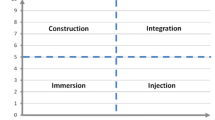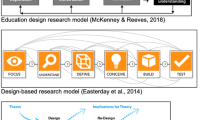Abstract
This paper presents the concept of critical flexibility as an alternative to eclecticism in instructional design. Eclecticism is often viewed as a persuasive alternative to theoretical orthodoxy (i.e., rigid use of a single perspective or process) due to the openness and flexibility it purports to offer. In contrast, the authors argue that eclecticism ignores or discourages critical reflection regarding background understanding (e.g., implicit assumptions and values) and perpetuates the lack of openness and flexibility commonly associated with orthodoxy. Critical flexibility, as an alternative to eclecticism, emphasizes an awareness of background understanding, but construes it as capable of being explicated, critically examined, adjusted in specific contexts, and refined or developed over time to facilitate increasingly flexible and effective design practices. The authors clarify the nature of critical flexibility as a general way of being involved in the design process, suggest how it helps overcome the traditional theory–practice split, and discuss several of its implications for scholarship and training.
Similar content being viewed by others
References
Argyris, C., & Schon, D. A. (1974). Theory in practice: Increasing professional effectiveness. San Francisco: Joeey Bass.
Bateson, M. C. (1994). Peripheral visions: Learning along the way. New York: Harper Collins.
Beail, N. (Ed.). (1985). Repertory grid techniques and personal constructs: Applications in clinical and educational settings. London: Croom Helm.
Bednar, A. K., Cunningham, D., Duffy, T. M., & Perry, J. D. (1992). Theory into practice: How do we link? In T. M. Duffy & D. H. Jonassen (Eds.), Constructivism and the technology of instruction: A conversation (pp. 17–34). Hillsdale, NJ: Lawrence Erlbaum Associates.
Bohman, J. (1991). New philosophy of social science. Cambridge, MA: MIT Pres.
Braden, R. A. (1996). The case for linear instructional design and development: A commentary on models, challenges, and myths. Educational Technology, 36(2), 5–23.
Brookfield, S. (1987). Developing critical thinkers: Challenging adults to explore alternative ways of thinking. San Francisco: Jossey-Bass.
Christensen, T. K., & Osguthorpe, R. T. (2004). How do instructional design practitioners make instructional-strategy decisions? Performance Improvement Quarterly, 17(3), 45–65.
Clark, R. E. (1989). Current progress and future directions for research in instructional technology. Educational Technology Research and Development, 37(1), 57–66.
Clark, R. E., & Estes, F. (1998). Technology or craft? What are we doing? Educational Technology, 38(5), 5–11.
Cognition and Technology Group at Vanderbilt. (1990). Anchored instruction and its relationship to situated cognition. Educational Researcher, 19(6), 2–10.
Der-Thanq, C., Hung, D., & Wang, Y. M. (2007). Educational design as a quest for congruence: The need for alternative learning design tools. British Journal of Educational Technology, 38, 876–884.
Dreyfus, H. L. (1991). Being-in-the-world: A commentary on Heidegger’s Being and Tine Division 1. Cambridge, MA: MIT Press.
Dreyfus, H. L., & Dreyfus, S. E. (1986). Mind over machine: The power of human intuition and expertise in the era of the computer. New York: Free Press.
Driscoll, M. P. (2000). Psychology of learning for instruction (2nd ed.). Boston: Allyn and Bacon.
Ely, D. P. (1999). Toward a philosophy of instructional technology: Thirty years on. British Journal of Educational Technology, 30, 305–310.
Engeström, Y., Hakkarainen, P., & Hedegaard, M. (1984). On the methodological basis of research in teaching and learning. In M. Hedegaard, P. Hakkarainen, & Y. Engeström (Eds.), Learning and teaching on a scientific basis (pp. 119–183). Aarhus Universitat: Psykologisk Institut.
Ertmer, P. A., & Newby, T. J. (1993). Behaviorism, cognitivism, and constructivism: Comparing critical features from an instructional design perspective. Performance Improvement Quarterly, 6(4), 50–72.
Ertmer, P. A., Stepich, D. A., York, C. S., Stickman, A., Wu, X., Zurek, S., et al. (2008). How instructional design experts use knowledge and experience to solve ill-structured problems. Performance Improvement Quarterly, 21(1), 17–42.
Gabbitas, B. W. (2009). Critical thinking and analyzing assumptions in instructional technology. Unpublished master’s thesis, Brigham Young University, Provo, Utah.
Gadamer, H. G. (1975). Truth and method (2nd ed.). New York: Continuum.
Gagné, R. M. (1985). The conditions of learning and theory of instruction (pp. 243–258). Forth Worth, Holt: Rinehart & Winston, Inc.
Garfinkel, H. (1967). Studies in ethnomethodology. Englewood Cliffs, NJ: Prentice Hall.
Hannafin, M. J., Hannafin, K. M., Land, S. M., & Oliver, K. (1997). Grounded practice and the design of constructivist learning environments. Educational Technology Research and Development, 45(3), 101–117.
Hannafin, M. J., & Hill, J. R. (2007). Epistemology and the design of learning environments. In R. Reiser & J. Dempsey (Eds.), Trends and issues in instructional technology (2nd ed., pp. 53–61). Upper Saddle River, NJ: Pearson Prentice-Hall.
Hardré, P. L., Ge, X., & Thomas, M. K. (2006). An investigation of development toward instructional design expertise. Performance Improvement Quarterly, 19(4), 63–90.
Heidegger, M. (1962). Being and time. New York: Harper and Row.
Honebein, P. C., & Goldsworthy, R. C. (2009). Is your design story limiting you? Purposefully perturbing our practices through instructional design “Mashups”. Educational Technology, 49(4), 27–33.
Hostetler, K. (1994). Community and neutrality in critical thought: A nonobjectivist view on the conduct and teaching of critical thinking. In K. S. Walters (Ed.), Re-thinking reason: New perspectives in critical thinking (pp. 135–154). Albany: SUNY Press.
Hunt, D. E. (1987). How to be your own best theorist. Theory into Practice, 26, 512–518.
Irving, J. A., & Williams, D. I. (1995). Critical thinking and reflective practice in counseling. British Journal of Guidance and Counseling, 23(1), 107–114.
Jonassen, D. H. (1991). Objectivism versus constructivism: Do we need a new philosophical paradigm? Educational Technology Research and Development, 39(3), 5–14.
Kirschner, P., Carr, C., van Merrienboer, J., & Sloep, P. (2002). How expert designers design. Performance Improvement Quarterly, 15(4), 86–104.
Krippendorff, K. (2006). The semantic turn: A new foundation for design. Boca Raton, FL: Taylor & Francis.
Lawson, B. (2006). How designers think: The design process demystified (4th ed.). New York: Architectural Press.
Lawson, B., & Dorst, K. (2009). Design expertise. New York: Architectural Press.
McDonald, J. K., Yanchar, S. C., & Osguthorpe, R. T. (2005). Learning from programmed instruction: Examining implications for modern instructional technology. Educational Technology Research and Development, 53(2), 84–98.
Merrill, D. M., Drake, L., Lacy, M. J., Pratt, J., & The ID2 Research Group. (1996). Reclaiming instructional design. Educational Technology, 36(5), 5–7.
Miller, C., & Hokanson, B. (2009). The artist and architect: Creativity and innovation through role-based design. Educational Technology, 49(4), 18–27.
Nelson, H. G., & Stolterman, E. (2003). The design way. Englewood Cliffs, NJ: Educational Technology Publications.
Osguthorpe, R. T., & Osguthorpe, R. D. (2007). Instructional design as living practice: Toward a conscience of craft. Educational Technology, 47(4), 13–23.
Osmo, R. (2001). A conceptual tool: making social workers’ assumptions explicit. Social Work Education, 20, 209–217.
Parrish, P. E. (2005). Embracing the aesthetics of instructional design. Educational Technology, 45(2), 16–25.
Parrish, P. E. (2009). Aesthetic principles for instructional design. Educational Technology Research and Development, 57, 511–528.
Polkinghorne, D. E. (2004). Practice and the human sciences: The case for a judgment-based practice of care. Albany: State University of New York Press.
Randi, J., & Corno, L. (1997). Teachers and innovators. In B. J. Biddle, T. L. Good, & I. F. Goodson (Eds.), International handbook of teachers and teaching (Vol. 3, pp. 1163–1221). Dordrecht, Netherlands: Kluwer Academic Publishers.
Reigeluth, C. M., & An, Y. J. (2009). Theory building. In C. M. Reigeluth & A. A. Carr-Chellman (Eds.), Instructional-design theories and models: Building a common knowledge base (Vol. 3, pp. 365–386). New York: Routledge.
Rorty, R. (1991). Inquiry as recontextualization. In R. Rorty (Ed.), Objectivity, relativism, and truth: Philosophical papers (Vol. 1, pp. 93–110). New York: Cambridge University press.
Rowland, G. (1993). Designing and instructional design. Educational Technology Research and Development, 41(1), 79–91.
Schank, R. C., Berman, T. R., & Macpherson, K. A. (1999). Learning by doing. In C. M. Reigeluth (Ed.), Instructional-design theories and models: A new paradigm of instructional theory (Vol. 2, pp. 161–181). Mahwah, NJ: Lawrence Erlbaum.
Schön, D. A. (1983). The reflective practitioner: How professionals think in action. Aldershot/Hampshire: Ashgate.
Slife, B. D., & Williams, R. N. (1995). What’s behind the research? Discovering hidden assumptions in the behavioral sciences. Thousand Oaks, CA: Sage Publications.
Smith, K. M., & Boling, E. (2009). What do we make of design? Design as a concept in educational technology. Educational Technology, 49(4), 3–17.
Spector, J. M. (2001). Philosophical implications for the design of instruction. Instructional Science, 29, 381–402.
Taylor, C. (1985). Philosophy and the human sciences: Philosophical papers (Vol. 2). New York: Cambridge University Press.
Tennyson, R. D. (2010). Historical reflection on learning theories and instructional design. Contemporary Educational Technology, 1(1), 1–16.
Tripp, S., & Bichelmeyer, B. (1990). Rapid prototyping: An alternative instructional design strategy. Educational Technology Research and Development, 38(1), 31–44.
Visscher-Voerman, I., & Gustafson, K. L. (2004). Paradigms in the theory and practice of education and training design. Educational Technology Research and Development, 52(2), 69–91.
Weideman, A. (2001). The old and the new: Reconsidering eclecticism in language teaching. Per Linguam, 17(1), 1–13.
Westerman, M. A. (2006). Quantitative research as an interpretive enterprise: The mostly unacknowledged role of interpretation in research efforts and suggestions for explicitly interpretive quantitative investigations. New Ideas in Psychology, 24, 189–211.
Wild, M., & Quinn, C. (1998). Implications of educational theory for the design of instructional multimedia. British Journal of Educational Technology, 29, 73–82.
Wilson, B. G. (1997). Thoughts on theory in educational technology. Educational Technology, 37(1), 22–27.
Winn, W. (1997). Advantages of a theory-building curriculum in instructional technology. Educational Technology, 38(1), 34–41.
Yanchar, S. C., Slife, B. D., & Warne, R. T. (2008). Critical thinking as disciplinary practice. Review of General Psychology, 12, 265–281.
Yanchar, S. C., & South, J. B. (2009). Beyond the theory-practice split in instructional design: The current situation and future directions. In M. Orey, V. J. McClendon, & R. Branch (Eds.), Educational media and technology yearbook 2009 (pp. 81–100). New York: Springer.
Yanchar, S. C., South, J. B., Williams, D. D., Allen, S., & Wilson, B. G. (2010). Struggling with theory? A qualitative investigation of conceptual tool use in instructional design. Educational Technology Research and Development, 58, 39–60.
Yanchar, S. C., & Williams, D. D. (2006). Reconsidering the compatibility thesis and eclecticism: Five proposed guidelines for method use. Educational Researcher, 35(9), 3–12.
Author information
Authors and Affiliations
Corresponding author
Rights and permissions
About this article
Cite this article
Yanchar, S.C., Gabbitas, B.W. Between eclecticism and orthodoxy in instructional design. Education Tech Research Dev 59, 383–398 (2011). https://doi.org/10.1007/s11423-010-9180-3
Published:
Issue Date:
DOI: https://doi.org/10.1007/s11423-010-9180-3




